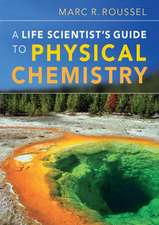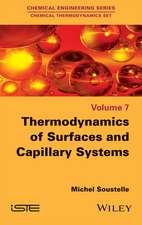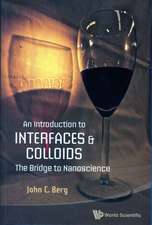The Law of Mass Action
Autor Andrei B. Koudriavtsev, Reginald F. Jameson, Wolfgang Linerten Limba Engleză Hardback – 20 mar 2001
| Toate formatele și edițiile | Preț | Express |
|---|---|---|
| Paperback (1) | 391.02 lei 6-8 săpt. | |
| Springer Berlin, Heidelberg – 30 oct 2012 | 391.02 lei 6-8 săpt. | |
| Hardback (1) | 398.53 lei 6-8 săpt. | |
| Springer Berlin, Heidelberg – 20 mar 2001 | 398.53 lei 6-8 săpt. |
Preț: 398.53 lei
Nou
Puncte Express: 598
Preț estimativ în valută:
76.26€ • 81.55$ • 63.58£
76.26€ • 81.55$ • 63.58£
Carte tipărită la comandă
Livrare economică 18 aprilie-02 mai
Preluare comenzi: 021 569.72.76
Specificații
ISBN-13: 9783540410782
ISBN-10: 3540410783
Pagini: 348
Ilustrații: XIV, 328 p.
Dimensiuni: 155 x 235 x 24 mm
Greutate: 0.66 kg
Ediția:2001
Editura: Springer Berlin, Heidelberg
Colecția Springer
Locul publicării:Berlin, Heidelberg, Germany
ISBN-10: 3540410783
Pagini: 348
Ilustrații: XIV, 328 p.
Dimensiuni: 155 x 235 x 24 mm
Greutate: 0.66 kg
Ediția:2001
Editura: Springer Berlin, Heidelberg
Colecția Springer
Locul publicării:Berlin, Heidelberg, Germany
Public țintă
ResearchCuprins
1 Maxwell — Boltzmann Statitics.- 1.1 Thermodynamics and probab ility. The Boltzmann — Planck theorem.- 1.2 The Maxwell — Boltzmann distribution law.- 1.3 Calculation of most probable and mean values.- 1.4 Indistinguishable molecules. The Gibbs’ paradox.- 1.5 Phase volume and the number of quantum states.- 1.6 Quantum statistics.- 2 Ensembles, Partition Functions, and Thermodynamic Functions.- 2.1 Gibbs— approach, or how to avoid molecular interactions.- 2.2 The process of equilibration and increasing entropy.- 2.3 Microcanonical distribution.- 2.4. Canonical distribution.- 2.5 The probability of a macrostate.- 2.6 Thermodynamic functions derived from a canonical distribution.- 2.7 Some molecular partition functions.- 2.8 Fluctuations.- 2.9 Conclusions.- 3 The Law of Mass Action for Ideal Systems.- 3.1 The law of mass action, its origin and formal thermodynamic derivation.- 3.2 Statistical formulae for free energy.- 3.3 Statis tical formul ae for ideal sys tems.- 3.4 The law of mass action for ideal gases.- 3.5 The law of mass act ion for an ideal crys tal. Spin crossover equilibria.- 3.6 Liquids.- 3.7 ‘Breakdown’ of the law of mass action.- 3.8 Conclusions.- 4 Reactions in Imperfect Condensed Systems. Free Volume.- 4.1 Additive volume: a semi-empirical model of repulsive interactions.- 4.2. Lattice theories of the liquid state.- 4.3 The Lennard-Jones and Devonshir e model.- 4.4 Chemica l equi libria in Lennard-Jones and Devon shire liquids.- 4.5 The non-id eal law of mass action, activities, and standard states.- 4.6 Kinetic law of mass action.- 4.7 Conclusions.- 5 Molecular Interactions.- 5.1 Introduction.- 5.2 Empirical binary potentials.- 5.3 Taking into account nearest, next nearest, and longer range interactions in the conde nsed phase.- 5.4Frequency of vibrations.- 5.5 The shape of the potential wcll in a cell.- 5.6 Free volume of a Lennard-Jones and Devons hire liquid.- 5.7 Experimental determ ination of parameters of the Lennard-Jones potential.- 5.8 Conclusions.- 6 Imperfect Gases..- 6.1 Introduction. The Virial Theorem.- 6.2 The Rayleigh equation.- 6.3 A gas with weak binary interactions: a statistical thermodynamics approach.- 6.4 Van der Waals equation of state.- 6.5 Chemical equilibria in imperfect gases.- 6.6 Conclusions.- 7 Reactions in Imperferct Condensed Systems. Lattice Energy.- 7.1 Exchange energy 203.- 7.2 Non-ideality as a result of dependence of the partition function on the nature of the surroundings.- 7.3 Exchange free energy.- 7.4 Phase separations in binary mixtures.- 7.5 The law of mass action for an imperfect mixture in the condensed state.- 7.6 The regular solut ion model of steep spin crossover.- 7.7 Heat capacity changes in spin crossover.- 7.8 Negative exchange energy. Ordering . The Bragg — Williams approximation.- 7.9. Description of order ing taking into account triple interactions.- 7.10 Chemica l equilibrium in ordered systems. Two-step spin crossover.- 7.11 Diluted systems.- 7.12 Conclusions.- 8 Chemical Correlations.- 8.1 Studies of variations of chemical reactivity.- 8.2 Linear free energy relationship. Modification of reactants.- 8.3 Linear free energy relationship. Variation of solvent.- 8.4 Isoequilibrium and isokinetic relationships.- 8.5 Conclusions.- 9 Concluding Remarks.- 10 Appendices.- 10.1 Lagrange equations and Hamilt on (canonical) equations.- 10.2 Phase space.- 10.3 Derivation of the canonical distribution.- 10.4 Free volume assoc iated with vibrations.- 10.5 Rotational con tribution to the equilibrium constant of the ionisation of water.- 10.6 Forms ofthe law of mass action employing the function approximation of the factorial.- 10.7 Derivation of the van der Waals equation of state.- 10.8 Exchange energy.- 10.9 Activity coefficients derived from the non-ideality resulting from triple interactions.- 10.10 The law of mass action for a binary equilibrium in a sys tem with non- additive volume and lattice energy.- 10.11 Physico-chemical constants and units of energy.
Recenzii
From the reviews:
J.AM. Chem. Soc., Vol. 124, No. 6, 2002: (...) The interested student may ask, "Where do I go from here? How do I handle nonideal gases and the most nonideal of gases, liquids and solids?". For this subset of students, this book is perfect. It reviews what needs to be reviewed and deals with the harder topics of chemical equilibrium in states that are less convenient than the ideal gas state. (...) For advanced, mathematically competent students, this is the perfect text. Carl David, University of Connecticut
"What can one say about a wonderful book … . The Law of Mass Action represents the culminating relationship of standard chemical thermodynamics, a sort of crown jewel of abstract reasoning putting the Gibbs’ free energy at the service of chemical equilibrium. … It reviews (succinctly) what needs to be reviewed and deals with the harder topics of chemical equilibrium in states that are less convenient than the ideal gas state. … For advanced, mathematically competent students, this is the perfect text." (Carl David, Journal of the American Chemical Society, Vol. 124 (6), 2002)
J.AM. Chem. Soc., Vol. 124, No. 6, 2002: (...) The interested student may ask, "Where do I go from here? How do I handle nonideal gases and the most nonideal of gases, liquids and solids?". For this subset of students, this book is perfect. It reviews what needs to be reviewed and deals with the harder topics of chemical equilibrium in states that are less convenient than the ideal gas state. (...) For advanced, mathematically competent students, this is the perfect text. Carl David, University of Connecticut
"What can one say about a wonderful book … . The Law of Mass Action represents the culminating relationship of standard chemical thermodynamics, a sort of crown jewel of abstract reasoning putting the Gibbs’ free energy at the service of chemical equilibrium. … It reviews (succinctly) what needs to be reviewed and deals with the harder topics of chemical equilibrium in states that are less convenient than the ideal gas state. … For advanced, mathematically competent students, this is the perfect text." (Carl David, Journal of the American Chemical Society, Vol. 124 (6), 2002)
Textul de pe ultima copertă
The theoretical basis of this book is developed ab ovo. This requires dealing with several problems arising in physical chemistry including the concept of entropy as a thermodynamic coordinate and its relation to probability. Thus Maxwell Boltzmann and Gibbs statistical thermodynamics, and quantum statistics are made considerable use of. A statistical mechanical derivation of the law of mass action for gases and solids is presented, and the problems arising in the application of the law of mass action to the liquid state are addressed. Molecular interactions and how to take them into account when deriving the law of mass action is discussed in some detail sketching a way alternativ to the use of activities. Finally, attention is drawn to the statistical mechanical background to Linear Free Energy Relationships (LFER's) and of Isokinetic Relationships (IKR's) and their connections with molecular interactions.
Caracteristici
The book gives the reader a compact exposition of the theoretical basis of one of the most important laws of chemistry from the point of view of statistical mechanics Although small, it nevertheless supplies all the material enabling a student in mastering some fundamental problems and get some practice in using nonideal forms of the law of mass action Includes supplementary material: sn.pub/extras











